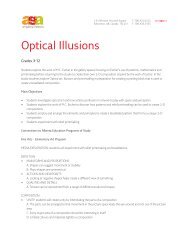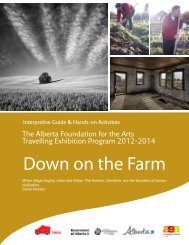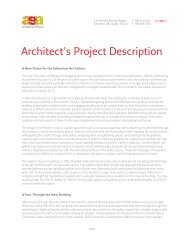A Bird in the Hand - Art Gallery of Alberta
A Bird in the Hand - Art Gallery of Alberta
A Bird in the Hand - Art Gallery of Alberta
- No tags were found...
You also want an ePaper? Increase the reach of your titles
YUMPU automatically turns print PDFs into web optimized ePapers that Google loves.
The <strong>Alberta</strong> Foundation for <strong>the</strong> <strong>Art</strong>s Travell<strong>in</strong>g Exhibition ProgramElements <strong>of</strong> Composition TourGrades 1 – 12Objectives:Through an exam<strong>in</strong>ation <strong>of</strong> selected works <strong>in</strong> <strong>the</strong> exhibition A <strong>Bird</strong> <strong>in</strong> <strong>the</strong> <strong>Hand</strong>, studentswill:a) learn what <strong>the</strong> elements <strong>of</strong> design areb) learn how <strong>the</strong> elements are used <strong>in</strong> art workc) apply <strong>the</strong>ir knowledge to o<strong>the</strong>r works <strong>in</strong> <strong>the</strong> exhibitionMethodology:1. Before view<strong>in</strong>g <strong>the</strong> exhibition, discuss with students what artists do and whatmaterials artists use to create <strong>the</strong>ir works.*artists create works which explore <strong>the</strong> world around <strong>the</strong>m; <strong>the</strong>y express<strong>the</strong>ir thoughts and feel<strong>in</strong>gs about <strong>the</strong> world and issues that <strong>the</strong>y feel areimportant. Traditionally artists used such materials as pa<strong>in</strong>t, rock, clay ormetal (for sculpture) and a host <strong>of</strong> draw<strong>in</strong>g materials such as <strong>in</strong>k, conté,charcoal, pastels or pencil crayons. Today, <strong>the</strong> range <strong>of</strong> materials hasexpanded to <strong>in</strong>clude everyth<strong>in</strong>g from garbage to raw meat. In o<strong>the</strong>r words,just about anyth<strong>in</strong>g can be used to create art.2. In <strong>the</strong> above discussion, <strong>in</strong>troduce <strong>the</strong> <strong>the</strong>me <strong>of</strong> elements <strong>of</strong> design– <strong>the</strong> “tools” artists use before us<strong>in</strong>g pa<strong>in</strong>t, pencils, paper etc.*l<strong>in</strong>e, shape, colour, texture, space – for example: Before a person candraw a house, what do <strong>the</strong>y have to use? Answer: l<strong>in</strong>es3. In <strong>the</strong> exhibition, A <strong>Bird</strong> <strong>in</strong> <strong>the</strong> <strong>Hand</strong>, focus on <strong>the</strong> follow<strong>in</strong>g works as<strong>the</strong>y relate to <strong>the</strong> elements <strong>of</strong> design:A) LINE: SEE Magpies, W<strong>in</strong>ter Sun by Ill<strong>in</strong>gworth KerrQuestions to Guide Inquiry:–What do you see <strong>in</strong> this work? -birds, landscape, mounta<strong>in</strong>s. There are l<strong>in</strong>es aroundeveryth<strong>in</strong>g.–How was this work created? What makes this image and composition? – <strong>the</strong>re are birds<strong>in</strong> <strong>the</strong> foreground, <strong>the</strong> landscape <strong>in</strong> <strong>the</strong> background. The l<strong>in</strong>es direct <strong>the</strong> <strong>the</strong> viewer’sattention towards <strong>the</strong> centre <strong>of</strong> <strong>the</strong> composition.–How would you describe <strong>the</strong> shape <strong>of</strong> <strong>the</strong> l<strong>in</strong>es? What o<strong>the</strong>r types <strong>of</strong> l<strong>in</strong>es could aperson make?AFA Travell<strong>in</strong>g Exhibition Program, Edmonton, AB Ph: 780.428.3830 Fax: 780.421.0479youraga.ca
















